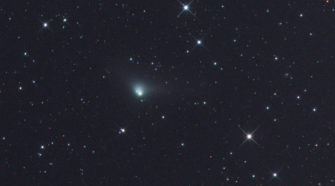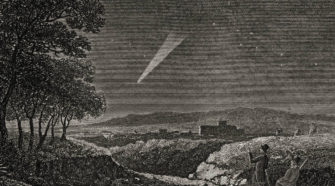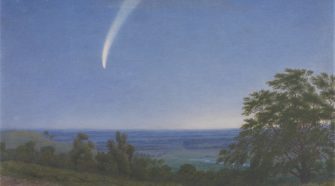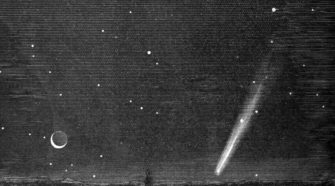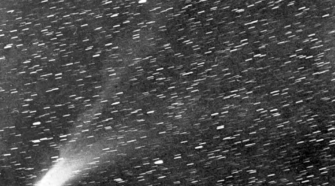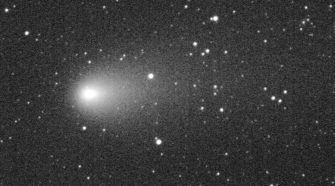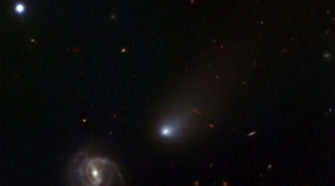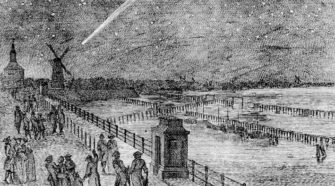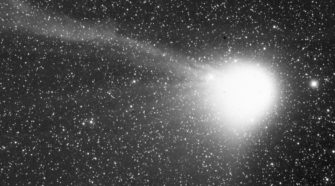Comet
Comet of the Week: Siding Spring C/2013 A1
Perihelion: 2014 October 25.30, q = 1.399 AU Of the various comprehensive survey programs that have been operational since the first such programs commenced in the late 1990s, only one has been based in the southern hemisphere: the Siding Spring Survey, based at its namesake observatory in New South Wales and which operated with funding …
Comet of the Week: The Great Comet of 1811
Perihelion: 1811 September 12.76, q = 1.035 AU Once the orbital calculations for Comet Hale-Bopp C/1995 O1 were made and it appeared that it would be making a “Great Comet” display a year and a half in the future, it was natural for those of us at the time to search for historical analogs. A …
Comet of the Week: Donati 1858 VI
Perihelion: 1858 September 30.46, q = 0.578 AU Among the many individuals who made important contributions to astronomy during the mid-19th Century was the Italian astronomer Giovanni Donati, who observed from the Observatory of Florence and who was Director of that institution from 1864 until his death (at age 46) in 1873. He made the …
Comet of the Week: The Great Comet of 1882
Perihelion: 1882 September 17.72, q = 0.008 AU What can arguably be considered as one of the brightest and most spectacular comets of the entire 2nd Millennium was a Kreutz sungrazer, one of the most pre-eminent representatives of that class of objects that is the subject of a future “Special Topics” presentation. It was first …
Comet of the Week: Delavan 1913f
Perihelion: 1914 October 26.77, q = 1.104 AU After the spectacular appearances of the Daylight Comet of 1910 and of Comet 1P/Halley later that same year – both of these objects having been discussed in previous “Ice and Stone 2020” presentations – the next few years brought some additional bright comets to Earth’s nighttime skies. …
Comet of the Week: 21P/Giacobini-Zinner 1984e
Perihelion: 1985 September 5.21, q = 1.028 AU The last comet discovered in the 19th Century was found on December 20, 1900, by the French astronomer Michel Giacobini from Nice Observatory, the fifth of twelve comets he discovered between 1896 and 1907. The comet was around 10th magnitude and was followed for two months, with …
Comet of the Week: 2I/Borisov I/2019 Q4
Perihelion: 2019 August 8.55, q = 2.007 AU According to our present understanding of how the solar system formed and evolved, all the various comets, including those passing through the inner solar system as well as those in the Kuiper Belt and the Oort Cloud, are the “leftovers” from the planet formation process. Over the …
Comet of the Week: SOLWIND 1 1979 XI
Perihelion: 1979 August 30.95, q = 0.005 AU The very first comet I ever observed, Comet Tago-Sato-Kosaka 1969g – a previous “Comet of the Week” – was also the first comet ever to be observed from space, an event which took place in mid-January 1970. Since that time many, many comets have been observed by …
Comet of the Week: Messier C/1769 P1
Perihelion: 1769 October 8.12, q = 0.123 AU As discussed in the “Special Topics” presentation on that object, in the early 18th Century the British astronomer Edmond Halley predicted that the comet that now bears his name would be returning around 1758. As that time approached several astronomers became involved in the effort to search …
Comet of the Week: Levy 1990c
Perihelion: 1990 October 24.68, q = 0.939 AU I’ve commented in previous “Ice and Stone 2020” presentations that I spent several hundred hours unsuccessfully hunting for new comets before giving up that endeavor, and then accidentally discovered the comet that bears my name three years later. I did the bulk of my hunting during the …

